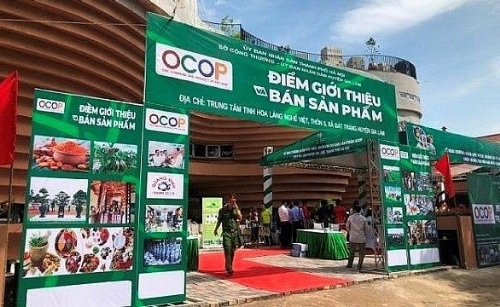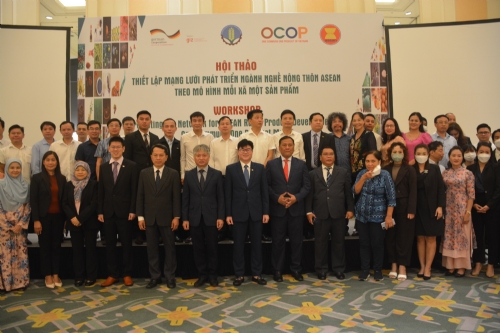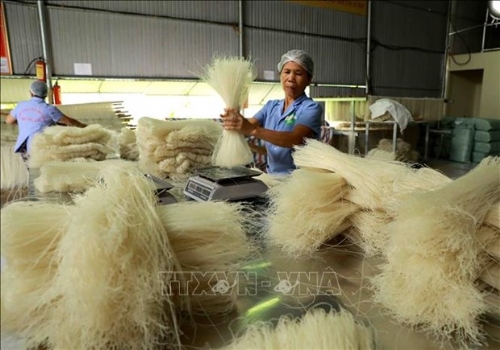Geographical indications should be effectively exploited
Wednesday, October 2, 2019 10:11

A farmer in Hưng Yên Province picks longan which were cultivated in accordance with VietGAP standards. – VNA/VNS Photo Phạm Kiên
HÀ NỘI — Although Việt Nam has many products with geographical indication (GI) certification, the country has failed to exploit the benefits, according to experts.
Hưng Yên longan is one example.
There are many varieties of longan nationwide, but Hưng Yên’s lồng longan, known as the fruit for kings, is famous for its thick pulp and sweet taste.
Hưng Yên’s lồng (cage) longan was ranked 13th in the top 50 famous fruits of Việt Nam and was registered with a national trademark and geographical indication.
However, many consumers still find it difficult to distinguish between Hưng Yên longan and longan from other localities.
Bùi Xuân Tám, Director of Nễ Châu Longan Cooperative in Hưng Yên City’s Hồng Nam Commune, said longans from other provinces often imitate Hưng Yên longan.
“When thinking about Hưng Yên, consumers immediately think of long longan, but in fact, there are nearly a dozen varieties of longan in the province,” he said, adding that the province has created a development strategy for Hưng Yên longan.
In the future, Hưng Yên would recommend growers of delicious longan varieties, which were favoured by consumers, and expand the farming in accordance with VietGAP (Vietnamese Good Agricultural Practices) standards.
Nguyễn Văn Quân, head of office of Hưng Yên Province’s Department of Agriculture and Rural Development, said longan without certificates were cheaper than those cultivated by renowned producers.
“It was a challenge to manage the sale of longan as they were sold by street vendors,” he said.
A survey conducted by the Ministry of Industry and Trade (MoIT) showed that only 9.5 per cent of enterprises and organisations regularly use GI.
Leaders of the MoIT said enterprises got support in terms of capital during the development of GI but after that they didn’t know how to take the next step.
Another reason was that GI was not granted to the right subject, they said.
GI violations were still taking place in many localities with specialties like Lục Ngạn lychee, Ngọc Linh ginseng or Phú Quốc fish sauce.
Recently, intellectual property development has been a concern and invested by localities. The number of products protected by GI has risen to 73 – mainly agricultural products such as fruits and seafood.
The GI has affected the perception of businesses and people about the product’s reputation and value. Therefore, the value and price of the product went up substantially.
Nguyễn Xuân Hà from Hòa Binh Province’s Cao Phong Orange JSC, said after obtaining GI, the price of orange doubled compared with before.
The economic value of orange cultivation was raised from VNĐ250 million to VNĐ700 million (US10,800 - $30,000) per one hectare.
In the past, traders used to bring oranges from other localities to Cao Phong District and sold them under this brand. However, Hà said, since the Cao Phong Orange Association was established, the issue has been solved because it was producers who best knew how to identify counterfeit products and who brought the products to the localities.
Chả mực Hạ Long (Ha Long grilled squid pie) had a similar experience.
After building a brand, the price of the product increased by 13-17 per cent, while consumption rose by 33-35 per cent, creating more jobs for local residents.
The current trend of the market requires products of clear origin and trademarks protected by authorities. Therefore, the registration of GI for products is very important in order to improve their value and competitiveness.
With the registration of GI, Vietnamese products are protected in the domestic market as well as have the opportunity to increase export output, particularly to demanding markets like the European Union or Japan.
Effective exploitation of GI
The GI registration is the first step in establishing ownership and legal factors related to local specialties.
In order to develop sustainably, it is necessary to have close coordination between ministries, including the Ministry of Science and Technology, the Ministry of Agriculture and Rural Development, and the Ministry of Industry and Trade in building and managing geographical indications, according to Đỗ Thắng Hải, deputy minister of industry and trade.
Localities, enterprises and trade associations also play an important role, he said.
Đào Thế Anh, Deputy Director of Field Crops Research Institute, said experience from some countries showed that small businesses and enterprises didn’t have enough financial capacity. Thus, the Government will support the use of GI through dissemination on these products’ information to consumers.
Currently, this support is feasible because the country has the "One Product One Commune" Programme (OCOP). The OCOP programme, which aims at promoting local products, would facilitate the exploitation and use of GI.
Once a product obtains GI registration, it should be quickly included in the OCOP Programme to get support in terms of marketing capacity and production as well as improve its quality, he said. VNS
Tố Như

 THE PROGRAM COOPERATED WITH CENTRAL COORDINATION FOR NEW-STYLE RURAL
THE PROGRAM COOPERATED WITH CENTRAL COORDINATION FOR NEW-STYLE RURAL
Other news
- HANOI: Promoting the consumption of craft village products and developing community tourism(11/5/2022 3:16:04 PM)
- Chuong My: Effectiveness from the One Commune One Product Program(11/3/2022 10:04:10 AM)
- Thanh Hoa develops OCOP products(11/1/2022 1:30:31 PM)
- Promoting the network for Asia Rural Product Development on one commune one product(8/30/2022 9:43:23 AM)
- Phu Tho eyes 56 new 3-star OCOP products for 2022(8/23/2022 3:09:56 PM)
- Opening of the OCOP product introduction week in Hanoi in 2022 in Phuc Tho district(8/1/2022 3:28:38 PM)
- Evaluation and classification of OCOP products Hoan Kiem District in 2022(7/27/2022 10:10:23 AM)
- Hanoi turns to green, sustainable agricultural sector(6/28/2022 4:10:22 PM)
- OCOP Forum in the Mekong Delta - Dong Thap 2022: Opening up great opportunities for regional products.(5/4/2022 2:38:13 PM)
- Over 1,000 spice products on display in Ho Chi Minh City(4/29/2022 2:34:02 PM)
The featured news
-
HANOI: Promoting the consumption of craft village products and developing community tourism
-
Promoting the network for Asia Rural Product Development on one commune one product
-
Phu Tho eyes 56 new 3-star OCOP products for 2022
-
Opening of the OCOP product introduction week in Hanoi in 2022 in Phuc Tho district
-
Evaluation and classification of OCOP products Hoan Kiem District in 2022






